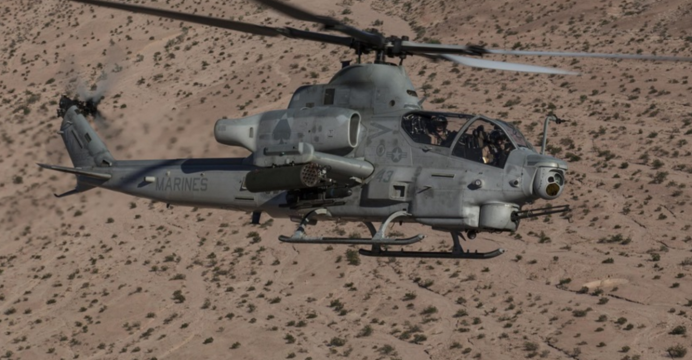nadeemkhan110
BANNED

- Joined
- May 17, 2015
- Messages
- 1,076
- Reaction score
- 0
- Country
- Location

The USMC AH-1Z Viper. Photo credit: Bell Helicopters
LOCKHEED MARTIN AWARDED TSS CONTRACT FOR PAKISTANI AH-1Z
ShareTweet
The U.S. Department of Defence (DoD) has awarded a contract to Lockheed Martin to supply its AN/AAQ-30 Target Sight Systems (TSS) for Pakistan’s Bell AH-1Z Viper dedicated attack helicopters.
The contract awarded as part of a larger sale – valued USD $151 million – for TSS units for both U.S. and Pakistani AH-1Zs. The Pakistani order (made under the Foreign Military Sales program) constitutes 12% of the contract (i.e. USD $18.12 million).
The AN/AAQ-30 TSS is essentially an electro-optical/infrared (EO/IR) sensor capable of nighttime imaging and laser-designation (for air-to-surface missiles such as the AGM-114R Hellfire II).
This is the second Pakistani TSS contract, the first being issued in January (for USD $14.2 million).
Notes & Comments:
In April 2015, the U.S. approved a proposed sale of 15 Bell Helicopters AH-1Z Viper attack helicopters to Pakistan. The USD $952 million deal included the aircraft, 1,000 AGM-114R Hellfire II air-to-surface laser-guided missiles, and requisite training, logistics, and maintenance support.
In August 2015 and April 2016, Pakistan ordered two and nine AH-1Z units, respectively. The TSS orders from January and December of this year correspond with those unit orders. As there were no options listed in the State Department notice, one should expect Pakistan to order the final four units.
In parallel with the AH-1Z program, the Pakistan Army will also induct four Mi-35 Hind assault helicopters, which it ordered from Russia in 2015 for USD $153 million. IHS Jane’s was told by Pakistani officials that the Army could procure a total of up to 20 Mi-35s.
Pakistan is also flying the Chengdu Aircraft Industry Group (CAIG) Z-10. It had also evaluated the Turkish Aerospace Industries (TAI) T-129. While the Pakistan Army is evidently seeking another dedicated attack helicopter platform, it is not clear how it intends to utilize a secondary platform.
The TAI T-129, while boasting superb hot-and-high flight attributes, is fundamentally a lightweight design. However, TAI, in collaboration with Meteksan, is testing the MİLDAR millimeter wave radar.
The CAIG Z-10 was recently spotted in a desert area in Punjab (i.e. Khairpur-Tamiwali near Bahawalpur), where it appeared to have been used as a close air support (CAS) platform for armour and infantry.
Pakistan was also reportedly interested in Mil Mi-28NE, which is among Russia’s newest attack helicopter platforms and, in contrast to the T-129 and Z-10, is a heavyweight design analogous to the AH-64.
Given the range of platforms it is examining, the Pakistan Army may simply be in the process of trying to determine which operational environments outside of counterinsurgency (COIN) require dedicated attack helicopters. Consequently, various platforms have been tested to their respective strengths, but a final decision is far from imminent.
Pakistan’s final decision will be shaped by how it intends to use its alternate attack helicopter platform. For example, a strong focus on anti-armour operations in Punjab and in Sindh would position a heavyweight platform such as the Mi-28NE (or Rooivalk Mk2) favourably. If unavailable, the Z-10 could be viewed as a medium-weight alternative for the same role. Alternatively, an emphasis on providing infantry in higher altitude mountainous areas would necessitate the T-129.
With the COIN effort set to continue, Pakistan’s attack helicopter fleet is poised to see heavy use in the coming years. With current AH-1F/S at the end of their lifespans, it would not be surprising if additional AH-1Zs are sought, especially under the Foreign Military Financing program, which is poised to resume (albeit with additional scrutiny in Washington).
Source: http://quwa.org/2016/12/26/lockheed-martin-awarded-tss-contract-for-pakistani-ah-1z/







